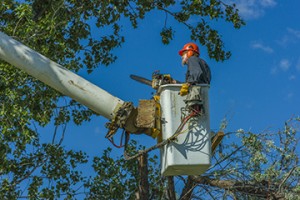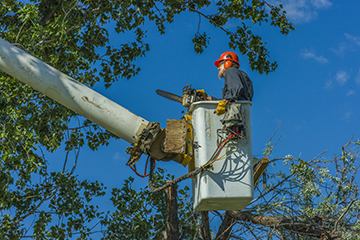 Many of us have observed a utility, such as the electric company, trimming trees away from the company’s lines on our property and may have thought, what gives the utility company the right to come onto my private property? The simple answer is what is called an “easement.” The article below is designed to inform the reader about easements and the rights and obligations of the respective parties to an easement.
Many of us have observed a utility, such as the electric company, trimming trees away from the company’s lines on our property and may have thought, what gives the utility company the right to come onto my private property? The simple answer is what is called an “easement.” The article below is designed to inform the reader about easements and the rights and obligations of the respective parties to an easement.
By definition, an easement is the mere right of a person to use for a definite purpose another person’s land in connection with his or her own land. An easement is not the complete ownership of land with the right to use it for all lawful purposes forever, but instead is a right that extends only to one or more particular uses. Most easements are created by creating a conveyance in a legal document that is recorded with the recorder of deeds where the property is located, commonly called an express grant of an easement. However, there are exceptions to the written easement, such as an easement of necessity, implied or visible easement and easement by prescriptive use.
Whether an easement is written in a conveyance or developed under one of the other theories, there will always be a servient tenement and a dominant tenement. A servient tenement is the person, whose land is being used for the easement, and the dominant tenement is the individual, neighbor, utility or other business granted the easement. An easement can be “exclusive,” which refers to the exclusion of the servient tenement from participation in the rights granted to the dominant tenement; or the grant can be “non-exclusive,” wherein the servient tenement retains the privilege of sharing the benefits conferred by the easement. Moreover, an easement’s use is limited to the purposes for which it was granted or has been used.
Easement of Necessity
An easement of necessity occurs where a parcel of real property is landlocked and rendered useless and there is not means for ingress or egress to the real property. In this instance, Missouri law provides two remedies to owners of real estate with no means of ingress or egress: (1) by statutory method under Mo.Rev.Stat. §228.340 or (2) by the common law easement by necessity. Under the statute, a property owner must prove that he owns the land, no public road goes through or alongside the land, and the private road the property owner is seeking is a way of strict necessity. This statutory scheme has been called a private right of condemnation. Under the common law of easement by necessity, a property owner must prove that both the servient and dominant tenements have a common source of title and a subsequent deprivation of access to a public road. In essence the common law remedy contemplates the dividing of real property, which leaves the owner of one of the severed parcels without means of ingress or egress. In both instances, the property owner seeking the easement must show proof of strict or absolute necessity.
Implied or Visible Easement
The doctrine of easement by implication from preexisting use has been defined as follows: Where the owner of land, has, by any artificial arrangement, effected an advantage for one parcel, to the burdening of the other, upon a severance of the ownership the holders of the two parcels take them respectively charged with the servitude and entitled benefit openly and visibility attached at the time of the conveyance of the parcel first sold. Therefore, to create an easement by implication from pre-existing use there must be: (1) one owner who owns the entire tract and a subsequent subdividing of the tract where the then subdivided parcels are sold; (2) an obvious benefit to one of the parcels and burden to the other parcel existing at the time of sale; (3) use of the property by the common owner in the property’s altered condition long enough before the parcels are sold and under such circumstances as to show that the change was intended to be permanent; and (4) reasonable necessity for the easement. Unlike easement of necessity, the benefit to the dominant tenement must be reasonably necessary to the use and enjoyment of the property, not strictly necessary.
Easement by Prescription
To establish a prescriptive easement, it is necessary to show use that has been continuous, uninterrupted, visible and adverse for a period of ten years. Continuity does not require any great quantum of actual use. A claimant who uses the prescriptive easement at his convenience, although infrequently, may still make out a claim for prescriptive easement. To meet the visible element, the party seeking the easement must show that the servient tenement had notice of the use and that the use was visible. Notice may be either actual or constructive, or inferred from the facts. Finally, to be considered adverse, for purposes of establishing an easement by prescription, is non-recognition of the owner’s authority to permit or prohibit use. This is because a permissive use of the land cannot ripen into an easement.
Use of an Easement
Much litigation has occurred due to the “reasonable” use of an easement. In most instances where an easement is granted, there will be language specifying the purpose of the easement, such as a driveway easement, road easement, etc. However, there are situations wherein the conveyance of an easement omitted the purpose of the easement, or an easement is granted under one of the above theories and parties to the easement are crying foul over an expanded or changed use of the easement or interference with an easement.
To determine reasonable use, when no purpose is specified in the conveyance or there is no express grant, the courts will look to the circumstances surrounding the creation of the easement, the location of the easement and how the easement has been previously used. Once the purpose is determined, the court will then examine whether the dominant tenement use of the easement is unreasonable. If there is a change in the quality of use, then the use is unreasonable because the use creates a substantial new burden on the servient tenement. An example is a grant of a roadway easement, for ingress and egress. The dominant tenement begins parking vehicles on the easement; this parking of vehicles is a change in the quality of use, because the easement is to be used only for ingress and egress. Parking is an additional burden which is not permissible and would be unreasonable. If the user of an easement exceeds his rights, either in manner or extent of use, the user is guilty of trespass to the extent of the unauthorized use and may be forced to pay damages incurred by the servient tenement.
Finally, as a dominant tenement can be found using an easement unreasonably, a servient tenement can be found to have interfered with the use of an easement. The owner of land burdened with an easement retains the right of full use of the land affected by the easement and may control and use the property in any way that does not substantially interfere with the reasonable use of the easement by the dominant tenement. If the servient tenement obstructs the use of an easement, the dominant tenement is well within his rights to remove the obstruction. Using the example above, if the servient tenement plants trees alongside the roadway easement and the trees begin growing into the roadway, blocking the dominant tenement’s use of the road, the dominant tenement can have the trees cut back. However, the dominant tenement can only have the trees cut back, not cut down, because if the trees are cut down, the dominant tenement can be guilty of trespass.


I have an easeway that Hopewell Village is the easeway holder. I am the subservient landowner and trying to get the municipality to fix the falling trees and erosion caused by their easeway. Who is responsible for maintaining the integrity of the easeway? I keep it clear from debris and obstructions is the way I understand the law.
This storm runoff is from other properties that spill through my front yard on the surface and runs like a river when it picks up speed and leaves exposed roots and cuts channels through the yard leaving it unusable. What can I do?
My property is landlocked and access is thru an easement. My neighbor in front of me has his own driveway to his home separate from the easement. He has been planting more and more very tall trees next to the easement, both sides. They have grown to overhang the middle. He is meticulous in care of his entire property but does not trim trees/bushes along the easement. It would be over a thousand dollars for me to pay for tree work for trees he planted on his property. The trees block access for hay trucks/emergency vehicles to get to my ranch. Should I have to pay for tree trimming or neighbor who is blocking access on easement to my ranch?
I am the servient landowner and have been in dispute for years whose responsibility it is to maintain the erosion and pollution from their storm runoff through my property. I know my responsibilities as to not block or obstruct but shouldn’t they be responsible if a tree fell on my house because of their erosion negligence?
Question: If a dead tree is on an easement for water line/electric who is responsible to remove the tree?
Several years ago FPL was preparing (auger in place but hole not dug) to replace a power pole. When I noticed they were in our 20’road easement, I confronted them telling them so and that the existing pole was at the edge of the road, thereby having a prescriptive easement and that’s where it should be placed. I showed them the plat survey for the development. The guy doing the project said they often place the pole in a road. He later wrote me an arrogant, bullying email saying I have to give them an easement to place the pole off our road. But they already have the easement including for the guy wires.
Another problem is a neighbor who has shirked their need to support maintenance/improvement of our road. All the other neighbor want to pave the road but we expect this cheapskate to not help. I’ve heard that Easement by Necessity can be used to obtain financial support for this community project.
This is just a synopsis of what we need to resolve.
I am servient tenement,4 dominant tenements. I am having issues with one which is about speeding & not respecting myself & 2 other dominant owners. I installed a gate that swings open & closed not locked. this was installed
acct of the speeding. also this person is not totally landlocked acct road up above him is a public road, and has parking & access to his home right below. he also is taking pictures of my land and trespassing to put up camera.
I have a neighbor abusing my easement I’ve granted them by letting there son driving reclessly by speeding up and down my road thus tearing up the gravel, plus putting my 5 year old son in danger, I’ve asked him to slow down but refuses my request, even flips me off on his way thru, I’ve contacted the police but to no avail. What can I do?? Speed bumps? I’m at a loss here….